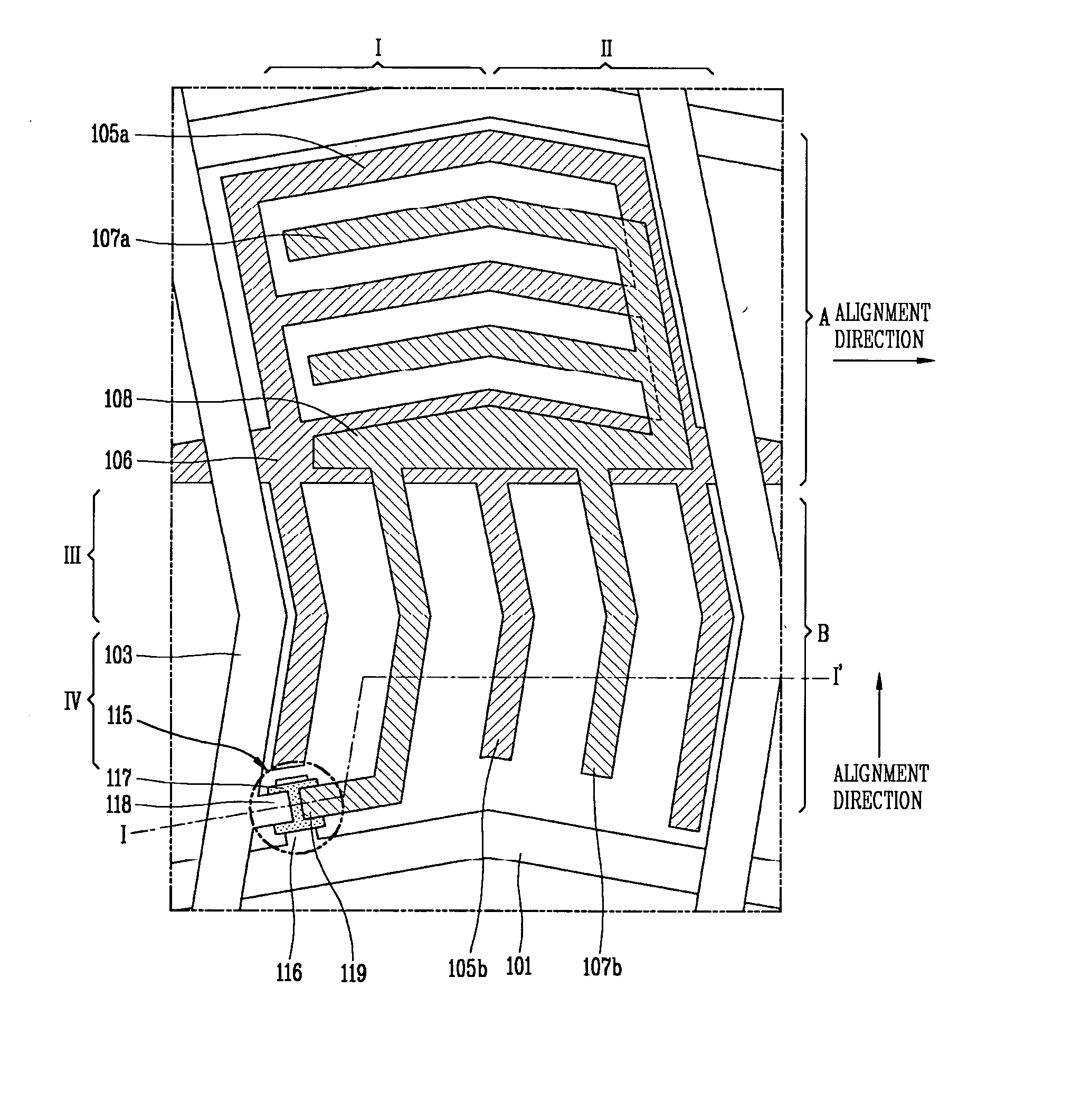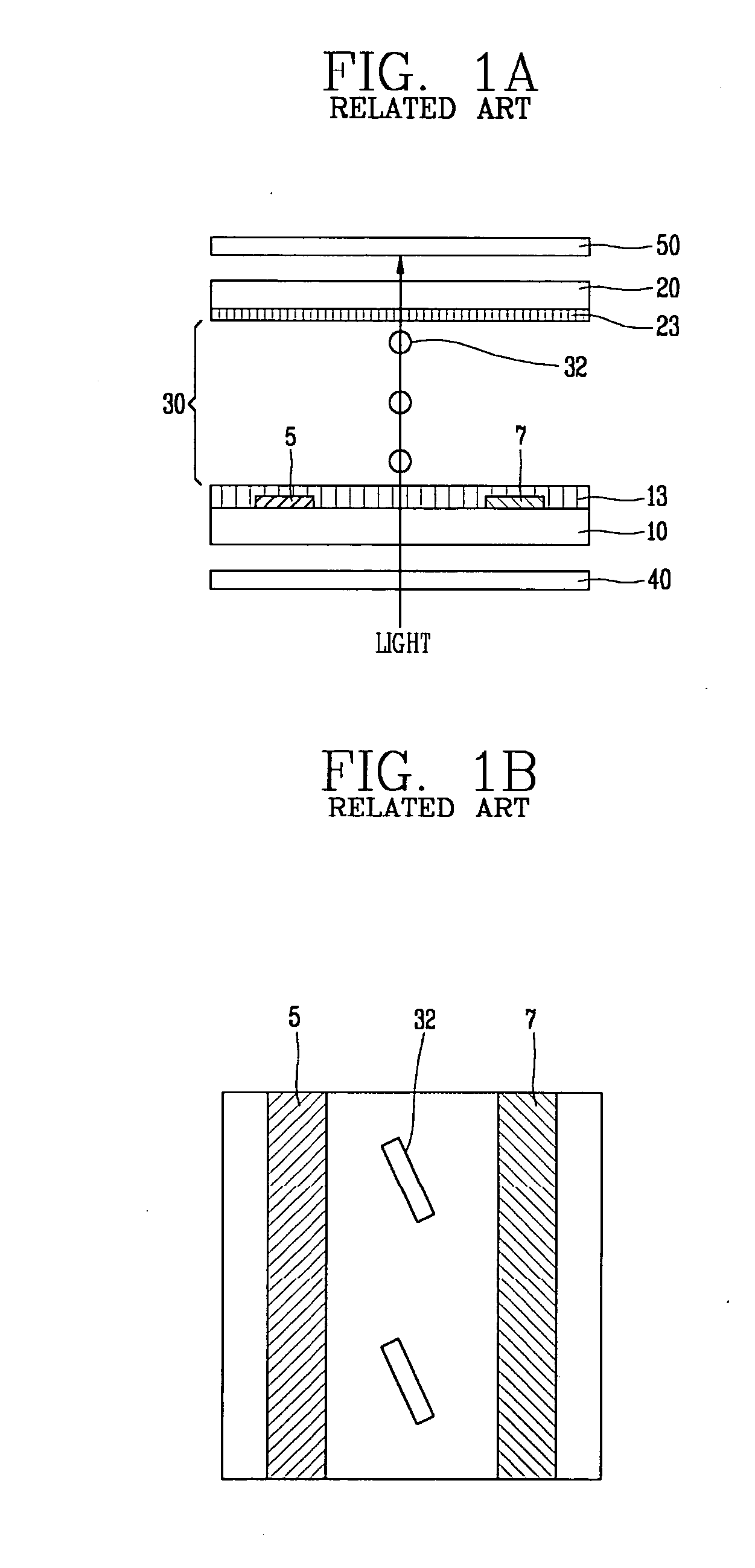In-plane switching mode liquid crystal display device having multi-domains
a liquid crystal display and multi-domain technology, applied in the direction of identification means, instruments, optics, etc., can solve the problems of narrow viewing angle, color shift along the viewing angle, image quality deterioration, etc., to prevent color shift and improve viewing angl
- Summary
- Abstract
- Description
- Claims
- Application Information
AI Technical Summary
Benefits of technology
Problems solved by technology
Method used
Image
Examples
first embodiment
[0030]FIG. 3 is a plan view illustrating the structure of the IPS mode liquid crystal display device according to this invention. At this time, only one pixel will be shown in the drawing for convenience of the description.
[0031] As shown in FIG. 3, the pixel is defined by the gate line 101 and data line 103, and the thin film transistor is disposed within the pixel. The thin film transistor includes a gate electrode 116 connected to the gate line 101 for applying a scan signal thereto, the semiconductor layer 117 over the gate electrode 116 to be activated by the scan signal to form a channel, and the source and drain electrodes 118,119 over the semiconductor layer 117.
[0032] The common electrodes 105a, 105b and the pixel electrodes 107a,107b are disposed in the pixel to form an electric field substantially parallel to the surface of the substrate. The common electrodes 105a, 105b and the pixel electrodes 107a, 107b are respectively connected to the common line 106 and the pixel e...
second embodiment
[0050] In the IPS mode liquid crystal display device of the second embodiment shown in FIG. 6, the pixel includes three-domains. Specifically, the pixel is divided into two regions A, B centering the gate line 201 and the upper region A is also divided into two domains. The common electrode 205a and the pixel electrode 207a are bent at a predetermined angle (for example, 4°-45°) in the upper region A. The common electrode 205a and the pixel electrode 207a are symmetric to each other. In the lower region B, the common electrode 205b and the pixel electrode 207b are arranged along the Y-axis direction (that is, arranged substantially parallel to the data line 203).
[0051] Because the alignment direction in the upper region A is formed in the X-axis direction, the liquid crystal molecules in the first domain I and the second domain II are twisted in an opposing direction when a signal is applied to the pixel electrode 207a. The alignment direction in the lower region B is formed to have...
third embodiment
[0054]FIG. 7 shows the present invention. For the convenience, we will only describe the structure different from the IPS mode liquid crystal display device of other embodiments.
[0055] The structure in FIG. 7 is similar to that of the second embodiment. The pixel includes three domains, that is, an upper region A having two domains and a lower region B. In the upper region A, the common electrode 305a and the pixel electrode 307a, which are respectively symmetric, are bent at an angle of about 5°-45° with respect to the X-axis direction, and the alignment direction is formed in the X-axis direction. The only difference between the third embodiment and the second embodiment are the elongated direction of the common electrode 305b and the pixel electrode 307b, and the alignment direction in the third domain III (i.e., the lower region B). As shown in FIG. 7, the common electrode 305b and the pixel electrode 307b are bent at an angle of about 5°-45° with respect to the Y-axis direction...
PUM
| Property | Measurement | Unit |
|---|---|---|
| angle | aaaaa | aaaaa |
| electric field | aaaaa | aaaaa |
| angle | aaaaa | aaaaa |
Abstract
Description
Claims
Application Information
 Login to View More
Login to View More - R&D
- Intellectual Property
- Life Sciences
- Materials
- Tech Scout
- Unparalleled Data Quality
- Higher Quality Content
- 60% Fewer Hallucinations
Browse by: Latest US Patents, China's latest patents, Technical Efficacy Thesaurus, Application Domain, Technology Topic, Popular Technical Reports.
© 2025 PatSnap. All rights reserved.Legal|Privacy policy|Modern Slavery Act Transparency Statement|Sitemap|About US| Contact US: help@patsnap.com



